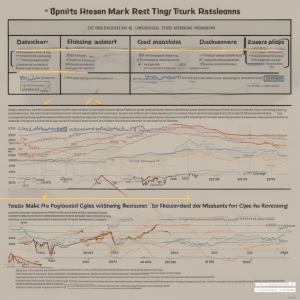Table of Contents:
Understanding financial markets and how they move is pivotal for investors and traders alike. Any trade's potential success largely depends on a trader's ability to accurately predict how the market will move. This can seem like an incredibly daunting task, especially for novices. One key to overcoming this challenge lies in understanding the concept of market cycles.
Introduction to Market Cycles in Trading
At its heart, a market cycle is a pattern or trend that emerges in the price movement of an asset class over time. This cycle encompasses four primary phases: accumulation, markup, distribution, and markdown. Each of these phases represents a specific trend in the market prices, alternating between periods of relative stability and volatility.
The fascinating aspect of market cycles is that they occur in virtually all tradable financial markets – including stocks, commodities, and yes, even cryptocurrencies. By mastering these cycles, traders can potentially time their trades for optimal returns. This is the kind of acumen that can turn a beginner into an experienced, successful trader.
Nevertheless, it's worth noting that while market cycles can provide a useful framework, they aren't set in stone. There's always room for market anomalies and unforeseeable events, known as black swan events, that can disrupt even the most established of cycles. Therefore, having a robust understanding of market cycles should be part of any trader's arsenal, but not the only tool.
Understanding the Market Cycle
In mastering market cycles, a clear comprehension of each cycle phase is essential. Let's delve into these phases:
The accumulation phase is the beginning of a market cycle. This is the time when experienced investors start buying up assets perceived to be undervalued, leading to a gradual rise in asset prices.
Following this is the markup phase where asset prices escalate rapidly. A significant spike in trading volume is also common in this phase as more traders join in on the buying frenzy.
The distribution phase follows afterward, signifying the peak of the market cycle where trading slightly plateaus because most traders begin to sell. This phase often happens when assets are seen by the majority as overvalued, prompting them to sell off their holdings.
The final phase, the markdown, occurs when asset prices fall rapidly. This often leads to the panic selling of assets before the market stabilizes, resetting the cycle back to the accumulation phase.
Understanding these stages enables a trader to gauge potential moves and make informed trading decisions. After all, the key to successful trading is timing, and market cycles provide a reliable compass for navigating volatile markets.
Pros and Cons of Timing Your Trades for Optimal Returns
| Pros | Cons |
|---|---|
| Can potentially maximize profits. | Requires an in-depth understanding of market cycles. |
| Minimal to no holding cost. | High risk if market predictions are incorrect. |
| Greater flexibility in responding to market changes. | Can lead to frequent trading, incurring more transaction costs. |
| Can take advantage of any market condition. | Requires constant monitoring of the market. |
| High potential returns in a short period. | May cause you to miss out on long-term gains. |
Phases of a Market Cycle

Recognizing the phases of a market cycle can provide valuable insights into trading strategies. Here's a more detailed look at each phase:
The Accumulation phase can be seen as the "smart money" phase. Assets are cheap, and savvy investors begin to enter the market, buying at low prices.
Next is the Markup phase. As the news about the asset picks up and becomes mainstream, more participants enter the market, increasing demand and driving up prices.
The Distribution phase is where experienced investors start to sell their holdings. They believe prices are approaching their peak, so they capitalize on their initial investments and exit the market.
Finally, the Markdown phase. This is when panic selling may occur. Prices are plummeting, leading to more selling. As a result, prices continue to decrease until the asset is once again seen as undervalued, and the cycle begins anew.
Studying these phases can help traders predict price movements, perfect their entry and exit points, and ultimately, generate a strong return on investment.
How to Time Trades in Market Cycles
Mastering the timing of trading within market cycles is a skill that can significantly improve a trader's performance. To do this effectively, one must observe the patterns of each cycle phase carefully. Here's how you can incorporate market cycle timing in your trading strategy:
During the accumulation phase, it's often a good idea to start investing, especially in assets perceived to be undervalued. While the risk may be high, the potential for high returns if correctly predicting the cycle’s upside is likewise substantial.
In the markup phase, you'll typically want to hold onto your assets and potentially buy more if the trend continues upwards. Be wary as the phase reaches its peak though, as the market may be on the brink of the distribution phase.
The distribution phase can be tricky. It requires careful evaluation of market stability and asset behavior, as incorrect predictions can lead to losses. Generally, it's sound to start considering selling your assets to capitalize on the price highs.
The markdown phase is usually not the best time to sell assets, given the falling prices. However, this phase presents an opportunity to buy assets at a discounted price, potentially gearing up for the next cycle’s accumulation phase.
Mastering the timing of these cycles requires practice, patience, and vigilance. Historical data, technical analysis, and market news are valuable resources that can guide your trading decisions within market cycles. However, as every cycle can be influenced by countless variables, it’s essential to remember that there are always risks involved in trading.
Strategies for Optimal Returns in Market Cycle Trading

Now that we have a clear understanding of the stages, let's look at some strategies for how to get the most out of market cycle trading.
Firstly, it's crucial to always pay attention to market indicators and news. Insights into economic conditions, industry developments, and changes in consumer behavior can provide valuable clues as to where we are in a market cycle. Such fundamental analysis could inform your trading decisions and help anticipate the transition between cycle phases.
Secondly, practice discipline and patience. Trading is not about rapid-fire decisions but making thoughtful and calculated moves. Resist the urge to get swept away by bullish hype during the markup phase or to panic during the markdown phase. Instead, remain focused on your long-term trading strategy.
Lastly, diversify your portfolio. Different asset classes can be at different stages of the market cycle at any given time. By spreading your investments across various asset types, you might be able to mitigate some risks and increase your chances of earning returns.
Remember, understanding and mastering market cycles in trading can significantly enhance your trading prowess and potential returns. However, it's essential to remember that market cycles are just one tool in your trading toolkit and should be used in conjunction with other trading strategies and risk management practices.
Practical Examples of Timing in Market Cycles
Let's explore practical examples of market cycles to solidify our understanding of timing in trading.
Consider a hypothetical scenario where an investor identifies the accumulation phase in the market cycle for a certain stock. The stock appears undervalued in respect to its true worth. This investor buys in large volumes, essentially accumulating the stock. This action commences a new market cycle.
Once demand increases, and the news about this stock starts to go mainstream, other market participants also begin to purchase shares. The stock value rises progressively leading to the markup phase. At this point, early investors are already making substantial returns.
Late in the markup phase, as the stock becomes overvalued, the early investors start selling off their holdings to earn profits, signaling the start of the distribution phase. Here, prices plateau as selling activities increase.
As the markdown phase sets in, prices fall rapidly due to panic selling by the late investors. This decline continues until the stock is considered undervalued again, and a new accumulation phase starts. In this instance, investors repeat the whole cycle, effectively timing their trades based on the market cycles.
It's important to note that reading these market cycles involves careful and detailed analysis. Moreover, such cycles are not confined to stocks alone but are evident in various asset classes like commodities, bonds, and cryptocurrencies.
The Role of Risk Management in Market Cycle Trading

While understanding and successfully timing market cycles can be beneficial, it's critical to remember that trading involves risk. There are no surefire guarantees in the trading world, regardless of how well you understand market cycles. Therefore, it's vital to incorporate efficient risk management in all your trading strategies.
Risk management in trading refers to the process of identifying, assessing, and taking steps to mitigate the uncertainties in a trade. The goal is to manage the level of risk you are willing to accept to achieve your investment objectives. Even when you believe you've identified a profitable trade set-up, risk management should still be applied.
This can involve setting stop-loss orders to limit potential losses, diversification to spread risk among different assets, or position sizing to manage the amount of capital invested in each trade. By utilizing these strategies and maintaining a balanced portfolio, you can mitigate potential losses while maximizing opportunities for profit, regardless of where you are in a market cycle.
In conclusion, while understanding market cycles can provide key insights and timing for trades, risk management should never be overlooked. Each plays an integral role in trading and, together, they can help traders navigate the volatile landscapes of the financial markets effectively.
Conclusion: Mastering Market Cycles in Trading
In conclusion, market cycles provide a valuable roadmap to timing trades for optimal returns. Understanding where an asset is in its cycle can give traders a significant edge, potentially yielding lucrative returns if the cycle is accurately anticipated and leveraged.
Appreciating that the market is cyclical and not linear requires a paradigm shift. A success in trading manifests when one is able to ride the waves of the market’s ebb and flow—buying low in accumulation, holding through markup, and selling high in distribution.
It’s worth reiterating, however, that the market remains a complex beast that can be influenced by a myriad of factors. Black swan events, economic shifts, and regulatory changes can all throw a wrench in the most well-adjusted market cycle predictions. As such, while mastering market cycles is an essential tool, it should be combined with other risk management strategies to ensure a robust approach to trading.
By cluing into market cycles, keeping an eye on external factors, and sticking to sound risk management principles, traders can cultivate the skills necessary to navigate the highs and lows of any market effectively. Empowering oneself with this knowledge is a concrete step towards making informed and successful trades.
Experiences and Opinions
Many users describe the challenges of timing trades effectively. A common issue is understanding market cycles. Users often feel overwhelmed by the volatility in markets, especially during economic downturns. Some traders note that recognizing patterns is essential for making profitable decisions.
Navigating market cycles requires practice. New traders frequently struggle with emotional responses. For example, panic selling during a downturn can lead to significant losses. Experienced traders suggest developing a systematic approach to trading. This often includes defining entry and exit points based on market trends.
Learning from Mistakes
Users emphasize the importance of learning from past mistakes. A common scenario involves buying into a rising market without considering potential reversals. Many traders report that they faced losses when they failed to recognize the end of a bullish phase.
In contrast, some traders advocate for a wait-and-see approach. They recommend observing market behavior before making trades. This strategy helps to avoid hasty decisions that could lead to financial loss. Resources like Investopedia provide valuable insights into market trends.
Utilizing Tools and Resources
Traders often rely on various tools to enhance their market analysis. Charting software and market indicators are popular among users. These tools help in visualizing price movements and identifying patterns. Many traders report that using these tools has improved their decision-making process.
Forums like Reddit's r/stocks allow users to share experiences and strategies. Participants discuss their successes and failures, providing a wealth of knowledge for others. Such discussions can illuminate common pitfalls and effective strategies.
Risk Management Strategies
Effective risk management is crucial. Many traders highlight the need for setting stop-loss orders. These orders help limit potential losses on trades. Users report that implementing risk management strategies has improved their overall trading performance.
Additionally, diversifying investments is a common recommendation. Spreading capital across different assets can mitigate risks associated with market fluctuations. Platforms like Morningstar provide tools for analyzing investment portfolios.
In conclusion, mastering market cycles is a continuous learning process. Traders must develop strategies based on their experiences. By leveraging tools, learning from mistakes, and managing risks, users can improve their trading outcomes. The journey may be challenging, but with the right approach, optimal returns are achievable.
Understanding Market Cycles: A Guide for Optimal Trading
What is market cycle?
A market cycle is a pattern or trend of financial markets to move in a certain direction over a certain period of time. These cycles are typically characterized by four phases: accumulation, markup, distribution, and markdown.
How can market cycles be used for trading?
Understanding market cycles can help traders time their trades for optimal returns. By identifying the phases of a market cycle, traders can make informed decisions on when to buy or sell assets.
What are some techniques to master market cycles?
There are various techniques to master market cycles; these include studying historical data, using technical analysis tools like trend lines and indicators, and staying informed about economic events and news that may impact market cycles.
What are the risks associated with trading based on market cycles?
The risks of trading based on market cycles include the possibility of misjudging the stages of a cycle, the impact of unforeseen events on markets, and the potential for markets to act unpredictably.
Can all types of assets be traded based on market cycles?
While market cycles can be observed across a variety of asset classes, their clarity and predictability may vary. Some assets may exhibit more pronounced cycles while others may be influenced by a wider range of factors that can make cycle prediction more challenging.











